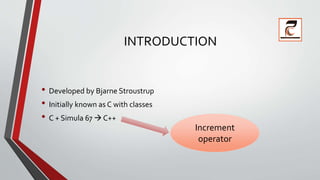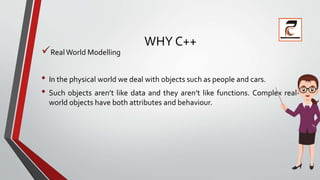Basics of c++
- 3. INTRODUCTION âĒ Developed by Bjarne Stroustrup âĒ Initially known as C with classes âĒ C + Simula 67 ï C++ Increment operator
- 4. WHY C++ PROBLEMS WITH STRUCTURED PROGRAMMING: ïžUnrestricted Access to GLOBAL DATA
- 5. WHY C++ ïžRealWorld Modelling âĒ In the physical world we deal with objects such as people and cars. âĒ Such objects arenât like data and they arenât like functions. Complex real- world objects have both attributes and behaviour.
- 6. ïžExamples of attributes (sometimes called characteristics) are, for people - eye colour and job title; ïžBehaviour is something a real-world object does in response to some stimulus. ïžIf you ask your boss for a raise, she will generally say yes or no.
- 7. What is class??? ïžUser defined datatype ïžSimilar to structure datatype ïžStructure + Data Hiding ï class ïžData is private by default ïžIncludes member variables and member functions in class definition Hiding data from another functions in order to avoid unintentional modification
- 8. What is class??? Member variable Member function
- 9. What is object??? ïžBlueprint of a class ïžInstance of a class ïžVariable of type class int rollno; student S1; Basic datatype User-defined datatype












